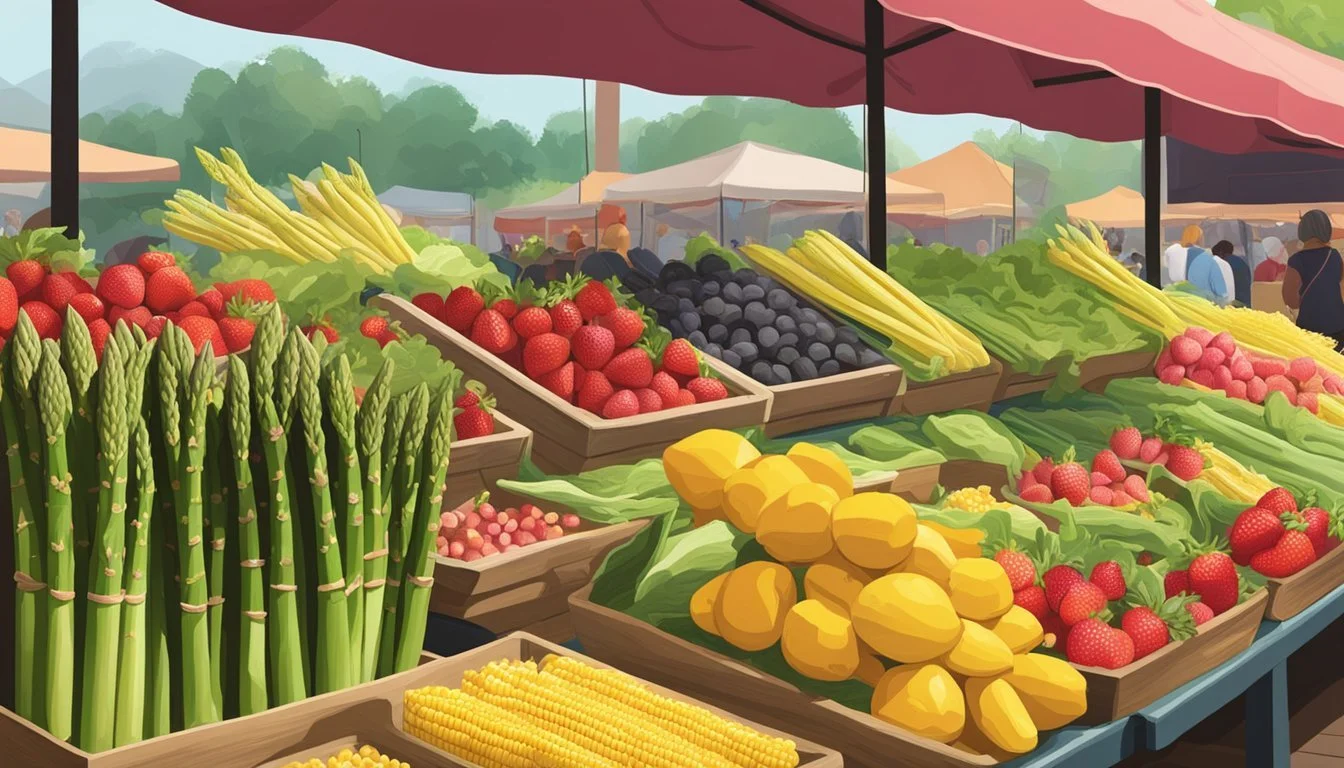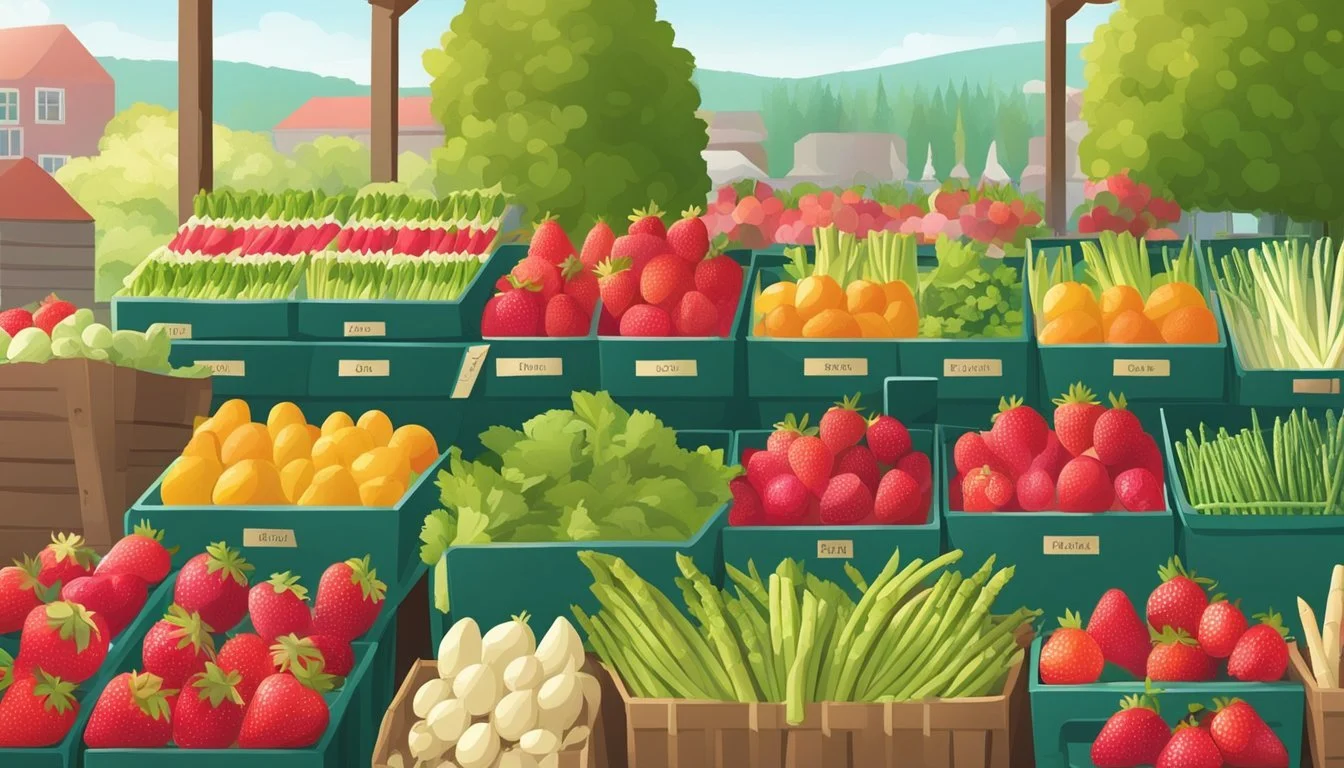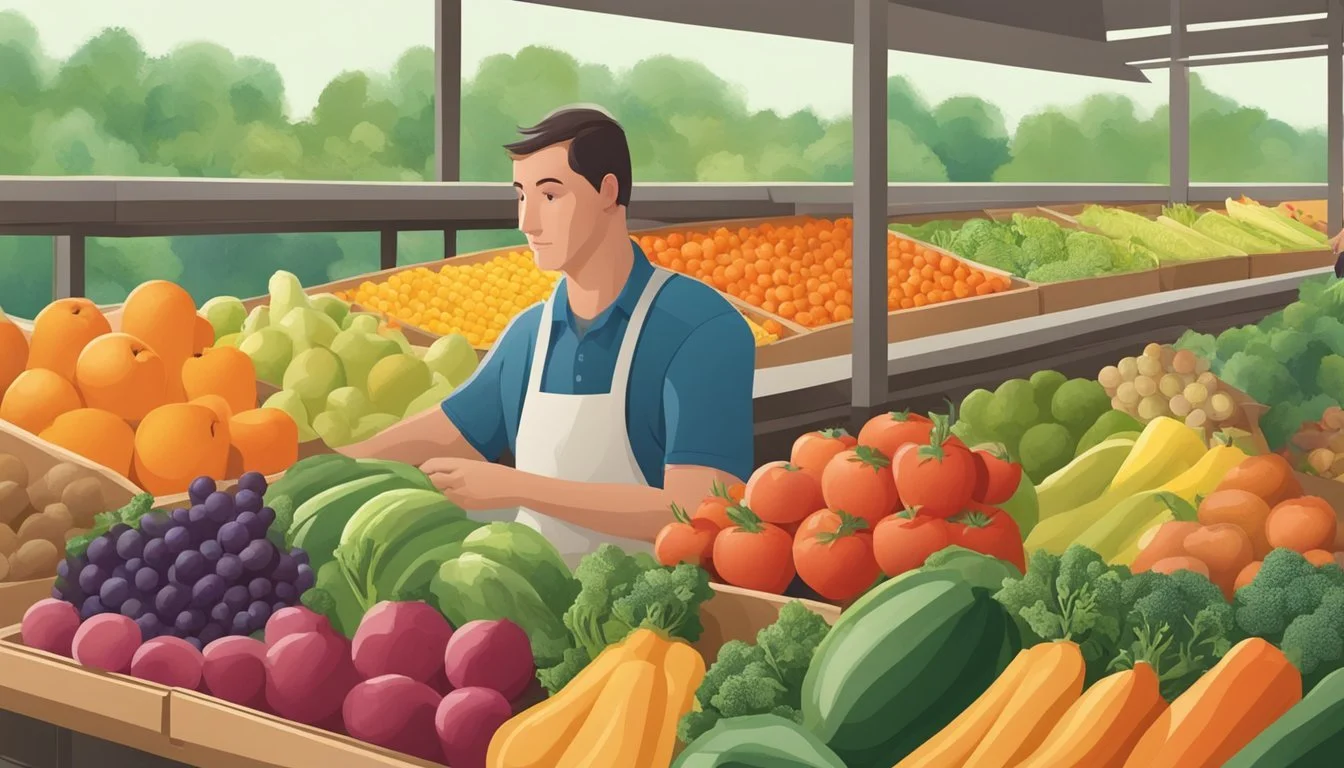Minnesota Seasonal Fruit & Vegetables in May
A Guide to the Freshest Picks
This Article is Part of our Minnesota Seasonal Fruit & Veg Calendar
As spring blossoms in Minnesota, the agricultural landscape begins to transform with the rebirth of lush greenery and the promise of a bountiful harvest. May marks the beginning of the growing season when farmers' markets start to fill with early produce. Consumers eager to incorporate fresh flavors into their meals have a variety of seasonal fruits (What wine goes well with fruits?) and vegetables to choose from. This month predominantly features the vibrant greens of spring, with produce like asparagus (how long does asparagus last?), rhubarb, and green onions coming into season.
The cooler climate of early spring in Minnesota is conducive to growing a selection of hardy vegetables. Asparagus shoots are harvested when they are tender and at their peak flavor, making them a much-anticipated arrival on the local food scene. Rhubarb, with its tart qualities, makes its appearance, often finding its way into traditional pies and jams. Furthermore, green onions add a subtle sharpness to dishes, showcasing their versatility in both raw and cooked form.
While the availability of fruit is more limited in May due to the late spring thaw, the focus remains on fresh, locally grown vegetables that are just beginning to flourish. Root vegetables such as radishes also make their debut, offering a crunchy and spicy component to salads and side dishes. The landscape of Minnesota's seasonal produce in May provides an opportunity to enjoy the fresh, early yields of the land while anticipating the variety of fruits and vegetables that the warmer months will bring.
Overview of Minnesota's Seasonal Production
Minnesota's harvest calendar is greatly influenced by its distinct seasons. The availability of produce fluctuates with the transition from the cold winters to the warm summers.
Understanding Crop Availability
In Minnesota, the arrival of May signifies the onset of the spring harvest season. This period is marked by the ready availability of a variety of spring crops, owing to the state's unique climate and soil conditions. For instance, asparagus emerges as one of the earliest vegetables, while rhubarb offers a tart addition to spring tables. Spinach (What wine goes well with spinach?) and radishes also thrive in the cool, early spring climate. Farmers' markets begin to showcase these crops, demonstrating Minnesota’s capacity to produce fresh, local food in alignment with natural growing cycles.
Spring Produce Availability Asparagus May Rhubarb May Spinach May Radishes May
The Impact of Weather on Harvest Times
The timing of Minnesota's produce harvest is directly affected by local weather conditions, which can vary significantly from year to year. Spring, often starting in May, can have fluctuating temperatures and precipitation rates. A warm, early spring can lead to an accelerated harvest, while a cool, lingering winter can delay crop availability. Notably, Minnesota growers are adept at adapting to these conditions, often utilizing greenhouses and cold frames to protect early-season crops from late frosts. The result is a resilient agricultural sector that provides Minnesotans with a reliable schedule of fresh produce throughout the seasons.
In summary, May in Minnesota showcases the state’s transition from the barren winter to a productive spring, with hardy vegetables that can withstand cooler temperatures starting to make their appearances in local markets.
Spring Harvest: What's In Season
In May, Minnesota's fields and gardens begin to offer a variety of fresh produce. This period marks the transition from the scarcity of winter to the bounty of summer, with a range of vegetables and fruits becoming available.
Highlighting May Fresh Produce
As the frost of winter fades, asparagus spearheads the local produce offerings, known for its tender and flavorful stalks.
Rhubarb also makes its debut, offering a tartness that is perfect for pies and desserts. Greens like spinach, lettuce, and radishes start to thrive, adding fresh and crisp options to May's harvest.
Herbs freshly snipped from the garden such as chives and parsley offer an aromatic touch to seasonal dishes.
The strawberry season begins to bloom towards the end of May, hinting at the sweet summer fruits to come.
Peas and green onions provide a mild, sweet flavor, perfect for fresh salads and cooking.
This array of produce found in May encourages a celebration of fresh, local, and seasonal eating.
Fruits and Vegetables Peaking in May
In May, Minnesota's agricultural offerings begin to flourish, providing a range of fresh vegetables and the early-season fruits that signal the start of spring.
Exploring Spring Vegetables
As the frost of winter thaws, spring vegetables take the spotlight in Minnesota. Root vegetables like radishes emerge crisp and peppery, perfect for salads and garnishes. Asparagus, a perennial favorite, offers its tender stalks, packed with flavor and versatility for a range of dishes from grilling to roasting. Leafy greens—including spinach—are at their tender best, ready to enhance any meal with a touch of freshness. Gardeners and farmers alike celebrate the harvest of green onions and peas, which add a burst of sweetness to the spring palate.
Enjoying the First Fruits of Spring
While the fruit selection in May is still burgeoning, rhubarb stands out as the star, with its tangy stalks ideal for pies and compotes. As the month progresses, the first strawberries begin to ripen, heralding the arrival of Minnesota's luscious fruit season. These vibrant berries are eagerly anticipated for their juicy sweetness and are often enjoyed fresh, in desserts, or as preserves.
Selecting and Storing Produce
Selecting high-quality produce and storing it effectively are critical for maintaining flavor and extending the shelf-life of fruits and vegetables. These steps ensure that the nutritional value is preserved whether the produce is consumed fresh, canned, or dried.
Choosing the Best Quality
Asparagus: Look for firm, bright green stalks with tight, purplish tips. Avoid any bunches that appear limp or have started to yellow.
Green Onions: Choose green onions with crisp, vibrant green tops and a firm white base. Smaller onions are typically more flavorful.
Rhubarb: Select stalks that are firm and deep red, as they tend to be sweeter and more tender. Avoid any with damage or heavy blemishes.
Spinach: Opt for spinach that has bright, vibrant leaves, which are indicative of freshness. Leaves should not be wilted or slimy.
Storage Tips for Freshness
Asparagus: Keep asparagus upright in a container with an inch of water in the refrigerator, or wrap the ends in a moist paper towel and cover with a plastic bag.
Green Onions: Store green onions in the crisper drawer of the refrigerator in a plastic bag. They can last up to one to two weeks when stored properly.
Rhubarb: Wrap rhubarb loosely in a plastic bag and place it in the crisper drawer. It can be stored for about a week.
Spinach: Store spinach in a plastic bag in the refrigerator. It’s best used within three to five days before it starts to lose its texture and flavor.
Preparing Seasonal Dishes
In May, Minnesota's bounty of seasonal produce such as asparagus, rhubarb, and strawberries offers a plethora of options for creating fresh and flavorful dishes. Utilizing these ingredients at their peak can transform simple meals into vibrant culinary experiences.
Cooking with Spring Produce
The arrival of spring heralds the availability of crisp vegetables and luscious fruits that are perfect for light and healthy recipes. One can take advantage of asparagus's versatility by incorporating it into a Spring Asparagus Pesto Pasta, a dish that showcases its tender texture and fresh taste. Making the most of rhubarb's tangy flavor, a compote or Rhubarb Salsa can be crafted, serving as a delightful accompaniment to grilled meats or a zesty dip.
Asparagus: Grill it, steam it, or shave it raw into salads.
Rhubarb: Prepare it in jams or pies for a perfect balance of sweet and tart.
Recipes Incorporating May Vegetables and Fruits
When devising recipes that highlight May's vegetables and fruits, one can create salads that burst with the flavors of the garden. For example, a salad based on spinach or arugula can be adorned with sliced strawberries, lending a sweet note to the verdant greens. Creating a Strawberry Balsamic Jam can elevate breakfast spreads and desserts alike.
Strawberries: Fresh in salads, or use them in jams and desserts.
Garden Salads: Combine multiple leafy greens with a variety of spring vegetables for a fresh garden salad.
Each spring fruit and vegetable can be celebrated in simple yet impactful dishes that resonate with the freshness of Minnesota's seasonal produce.
Local Markets and Farm Stands
May in Minnesota brings fresh, local produce directly to consumers through a network of vibrant farmers markets and farm stands. These venues not only provide access to fresh food but are a cornerstone of local agriculture.
Navigating Minnesota's Farmers Markets
Farmers markets in Minnesota become bustling hubs in May, offering a wide range of spring produce. Shoppers can find them scattered throughout the state, from the Twin Cities to rural towns. What's in season becomes readily available, including tender asparagus, tangy rhubarb, and a variety of leafy greens like spinach. Here's a brief guide to help navigate these markets:
Find a Market: The Minnesota Grown directory is a resource for locating farmers markets near you.
Know the Season: Buying in-season ensures the freshest produce, so look for items like green onions and radishes in May.
It’s advisable to arrive early for the best selection and to carry cash, though some vendors may accept other forms of payment.
Farm to Table: Buying Directly from Growers
Buying directly from local growers means consumers can enjoy fruits and vegetables at their peak freshness. Farmers in Minnesota take pride in offering produce that often goes from farm to table in less than 24 hours. This practice supports the local economy and minimizes the carbon footprint associated with transporting food long distances. When visiting a farm stand, customers should:
Ask Questions: Engage with growers to learn about their farming practices and the produce they offer.
Try Something New: Farm stands often have unique varieties not found in supermarkets, providing an opportunity to expand culinary horizons.
Purchasing directly at these stands not only benefits the local agricultural community but also ensures that the consumer is receiving some of the freshest possible options available.
Gardening and Growing Your Own
In Minnesota, May is a pivotal month for gardeners to start planting and tending to their fruit and vegetable gardens. The following subsections provide specific guidance for establishing a home vegetable garden and tips for growing fruit in the cold Minnesotan climate.
Starting a Home Vegetable Garden
In starting a home vegetable garden, the first step should be to select a suitable location that receives ample sunlight for at least six hours per day. This is critical, as most vegetables thrive in full sun. Next, gardeners should focus on soil preparation. A rich, well-drained loam is ideal for most vegetable crops. Incorporating organic matter such as compost improves soil structure and nutrient content. Gardeners in Minnesota typically start with cool-season crops in May, such as lettuce, spinach, and radishes, which can tolerate the last frosts common in the state’s climate. It is essential to follow a planting schedule appropriate for Minnesota's USDA Hardiness Zones, ranging from Zone 3-5, to maximize success.
Tips for Growing Fruit in Minnesota
When it comes to growing fruit in Minnesota, selecting the right varieties that can withstand the colder climate is key. Hardy fruits such as raspberries, strawberries, and blueberries can do well when planted in May, as they can survive the tail end of the cold season with proper care. For successful fruit growth, one should ensure good air circulation to prevent diseases, and adequate spacing between plants to reduce competition for nutrients. Moreover, consistent watering, especially during the establishment phase, is vital to help develop strong root systems. It is beneficial to mulch around the base of fruit plants to retain soil moisture and regulate soil temperature.
Seasonal Eating and Nutrition
In May, Minnesota residents have access to a variety of fresh, locally grown fruits and vegetables. These seasonal offerings boast heightened levels of flavor and nutrition, providing a host of health benefits to consumers.
Health Benefits of Seasonal Produce
Seasonal produce is typically harvested at its peak of ripeness, which means it contains an optimal level of nutrients, including essential vitamins, minerals, and fiber—a key component for a balanced diet. Eating seasonally also supports local farming and can lead to a more varied diet as different produce items become available throughout the year.
Fruits such as strawberries begin to appear in Minnesota during May. These are not only rich in flavor but also packed with vitamin C, antioxidants, and fiber, contributing to heart health and aiding in digestion.
Vegetables available may include:
Green Onions: Providing essential nutrients like vitamin K and vitamin C.
Rhubarb: Although often used as a fruit in dishes, rhubarb offers dietary fiber and vitamin C.
Spinach: High in iron and calcium, spinach is a versatile green that contributes to bone health and energy levels.
When individuals consume vegetables that are in season, they not only enjoy fresher, tastier ingredients but also the enhanced health benefits that coincide with eating foods that haven't been stored for long periods. Furthermore, these seasonal fruits and vegetables can act as natural supporters of the body's nutritional needs.
Looking Ahead: Upcoming Crop Availability
As May flowers bloom, Minnesota's harvest calendar ushers in an abundance of fresh produce. The transition from spring to early summer marks a significant expansion in crop variety, with several staple vegetables and fruits reaching their optimal picking time.
What to Expect in June and Beyond
June welcomes a broader spectrum of fresh Minnesota-grown produce. Residents can anticipate the following crops to start appearing in their local markets:
Tomatoes: Warmer temperatures allow tomatoes to thrive, with early varieties ready for harvest.
Beans: Both bush and pole beans begin to mature, making them a fresh pick for June.
Blueberries: Look out for these sweet, nutrient-packed berries as they come into season.
Carrots: Tender and flavorful, young carrots are harvested this month.
Garlic: Fresh garlic bulbs are typically ready to add zest to any dish.
Potatoes: Early potato varieties start to become available during this time.
Farmers' markets and local stands will showcase these produce, straight from the field to consumers:
Produce Harvest Begins Tomatoes Early June Beans June Blueberries Mid to Late June Carrots Early June Garlic Early June Potatoes Early June
As families and food enthusiasts visit markets, they should keep an eye out for these crops to enjoy the freshest flavors that Minnesota has to offer.










